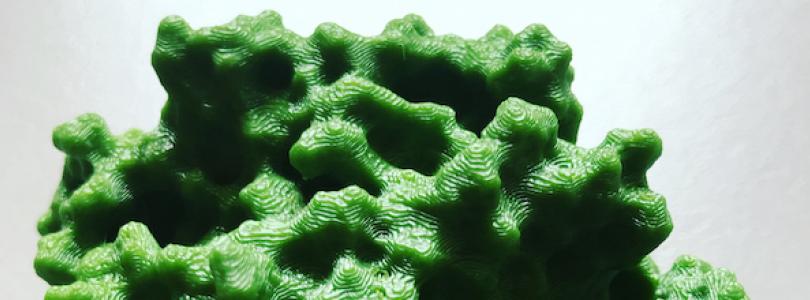
The SBF has a Facility software licence for Pymol, available for registered users. Please contact Kate for details on accessing this software.
The Facility has two GPU terminals suitable for model building, refinement and molecular dynamic simulations.
The Rock Imager is able to be controlled remotely for registered users. Please contact Kate for access.
The SBF also has a 3D printer for the purpose of printing protein models for scientific education.
Below is a list of useful links to external websites for Structural Biology (if any of the links don't work or you have something else you suggest should be added please email Kate: k.michie@unsw.edu.au).
- RCSB Protein Data Bank-Central protein structure repository
- Collaborative Computational Project No. 4 Software for Macromolecular X-ray Crystallography (CCP4)- Core crystallography software
- Phenix- Core crystallography software
- Isolde- Molecular dynamics for model building (useful for crystallography and cryo-EM structures)
- UCSF ChimeraX
- Pymol - Software for viewing and rendering PDB models.
- ANSTO Australian Synchrotron Macromolecular Crystallography
- Crystallographic Space Group Diagrams and Tables (http://img.chem.ucl.ac.uk/sgp/mainmenu.htm)
Optimisation of Crystallographic Models
- PDB Redo (https://pdb-redo.eu)
Crystallizability Prediction
- XtalPred-RF (https://xtalpred.godziklab.org/XtalPred-cgi/xtal.pl)
Biomolecular Simulation Programs and Docking Programs
- Amber (http://ambermd.org/index.php)
- Docking
- Fast docking
OpenEye programs (https://www.eyesopen.com/oedocking) - QM based docking
AutoDock (http://autodock.scripps.edu/)
GOLD (https://www.ccdc.cam.ac.uk/solutions/csd-discovery/Components/Gold/) - Commercial packages
GLIDE (https://www.schrodinger.com/products/glide)
- Fast docking
Cryo EM Software:
- Cryosparc (https://cryosparc.com/)
- Relion (https://www3.mrc-lmb.cam.ac.uk/relion/index.php/Main_Page)
https://relion.readthedocs.io/en/latest/Installation.html - Eman 2 (https://blake.bcm.edu/emanwiki/EMAN2)
- IMOD (https://bio3d.colorado.edu/imod/)
- MotionCor2 (https://emcore.ucsf.edu/ucsf-software)
- Gctf (https://www2.mrc-lmb.cam.ac.uk/research/locally-developed-software/zhang-software/)
- CTFFIND-4.1 (https://grigoriefflab.umassmed.edu/ctf_estimation_ctffind_ctftilt)
- ResMap (http://resmap.sourceforge.net/)
- Warp (http://www.warpem.com/warp/)
Useful Bioinformatics Sequence links:
- BLAST search (tblastn): https://blast.ncbi.nlm.nih.gov/Blast.cgi
- Jack Hmmr: https://www.ebi.ac.uk/Tools/hmmer/search/jackhmmer
- Clustal Omega: http://www.clustal.org
- Muscle: https://www.ebi.ac.uk/Tools/msa/muscle/
- Jalview: https://www.jalview.org/
Protein Structure Comparison:
- DALI (http://ekhidna2.biocenter.helsinki.fi/dali/)
- CATH (http://www.cathdb.info/search/by_structure)
Secondary structure prediction algorithms.
- Jpred4: http://www.compbio.dundee.ac.uk/jpred4/index.html
- COILS: https://www.expasy.org/resources/coils
Proteins, Domains, motifs and modifications
- UniProt (https://www.uniprot.org/)
Summary of everything known about a particular protein sequence. A great place to start! A comprehenisve resource of protein sequence and functional information. - PISA (https://www.ebi.ac.uk/pdbe/pisa/pistart.html)
PDBePISA is an interactive tool for the exploration of macromolecular interfaces. - Prosite: https://prosite.expasy.org/
- https://prosite.expasy.org/scanprosite/
- http://www.ebi.ac.uk/interpro/search/sequence/
- https://www.ebi.ac.uk/pdbe-site/pdbemotif/
- https://www.expasy.org/resources/uniprotkb-swiss-prot
- https://www.expasy.org/search/Protein%20feature%20detection?type=keyword
- PhosphoSite https://www.phosphosite.org/homeAction
Protein modification database
- Clinvar (https://www.ncbi.nlm.nih.gov/clinvar/)
Database of clinical variations in humans- great for finding missense mutations in your favorite protein.
- MisSense3D http://missense3d.bc.ic.ac.uk/missense3d/
Missense3D predicts the structural changes introduced by an amino acid substitution and is applicable to analyse both PDB coordinates and homology-predicted structures.
Please cite: Ittisoponpisan, S., Islam, S.A., Khanna, T., Alhuzimi, E., David, A. & Sternberg, M.J.E. (2019)
Can Predicted Protein 3D Structures Provide Reliable Insights into whether Missense Variants Are Disease Associated? J. Mol. Biol. 431, 2197-2212.
https://doi.org/10.1016/j.jmb.2019.04.009
3D structure prediction
Whatever you do... get these papers and read them, then have a go a the links below:
- Mirdita M, Ovchinnikov S and Steinegger M. ColabFold - Making protein folding accessible to all.
bioRxiv (2021) doi: 10.1101/2021.08.15.456425 - If you’re using AlphaFold, please also cite:
Jumper et al. "Highly accurate protein structure prediction with AlphaFold."
Nature (2021) doi: 10.1038/s41586-021-03819-2 - If you are using RoseTTAFold, please also cite:
Minkyung et al. "Accurate prediction of protein structures and interactions using a three-track neural network."
Science (2021) doi: 10.1126/science.abj8754
- Alphafold2
The code for Alphafold2 has been publicly released! Note that currently there is no free web-server that runs the FULL unlimited version of this software. Please contact Dr Michie in the SBF if you want to run a sequence on a fully implemented version of Alphafold2 (now available at UNSW from Aug 2021, with thanks to support from ResTech).Below are sites that enable you to run a sequence on a 'lite' version of Alphafold2 or one limited in sequence length:
- Official Deepmind Alphafold Colab Notebook
This is an online link to a Google notebook that will allow you to run a protein structure prediction. Note: It is NOT the full version of Alphafold2.
https://colab.research.google.com/github/deepmind/alphafold/blob/main/notebooks/AlphaFold.ipynb
- Moonbear (https://www.getmoonbear.com/AlphaFold2)
I can't find much information about this server but from my testing it is behaving like a 'full version' of Alphafold2 and predicts a structure that we know really needs the full version of Alphafold2 to fold. (We have tested this structure on the servers below and it is incorrect). People comment however that it won't run long sequences. If your sequence won't run of this server please drop me a line and I can run it on UNSW's implementation. This implementation apparently is by Stephanie Zhang and Neil Deshmukh.
- https://colab.research.google.com/github/sokrypton/ColabFold/blob/main/AlphaFold2.ipynb
Note: this link to a Google notebook enables you to run any protein sequence on a 'lite' version of Alphafold2 with the MMseq2 server for sequence alignment creation.
- This notebook modifies deepmind's original notebook to add experimental support for modeling complexes (both homo and hetero-oligomers), option to run MMseqs2 instead of Jackhmmer for MSA generation and advanced functionality. https://colab.research.google.com/github/sokrypton/ColabFold/blob/main/beta/AlphaFold2_advanced.ipynb
- EBI Alphafold Protein Structure Database (https://alphafold.ebi.ac.uk)
Repository of Alphafold predicted protein structures determined by EBI and Deepmind. Initial focus on human proteome, followed by model organism proteomes, followed eventually by all protein sequences. - Using Alphafold models for Molecular Replacement
Notes on using Alphafold models for X-ray data phasing for structure solution (taken from Claudia Millan's (@cheshireminima) twitter comments Aug 7th 2021:
- Since the publication of #AlphaFold2 and #RoseTTAFold and now that the tools and models have been made accessible, there has been an avalanche of attempts to solve old crystal structures. This thread covers tips from the #PhaserTeam for doing #MR with these models.
- The first thing to be aware of is that the B-factor fields contain measures of confidence in the correctness of the prediction, not actual B-factors. This means: 1) we can use that confidence to trim the model and 2) we need to convert that to an appropriate B-factor.
- Phaser will take those B-factors and use them to weight the different parts of the model. This can improve your chances of success with the model.
- If your model comes from the #RoseTTAFold server, it will have an estimated rmsd error in A in the B-factor column. They already give the option to obtain versions of the model from which atoms with an error estimate over some value have been trimmed.
- For #MR in #phaser you should process the #RoseTTAFold model. From the latest nightly build from #phenix, you can use our tool phenix.voyager.rmsd_to_bfactor to process those error estimates to B-factors and also optionally trim the model.
- If your model comes instead from the #AlphaFold database at the #EBI, or from their Colab notebook, the metric on their B-factor column is the LDDT. This is the score that is shown as quality metric, and is a percentage with 100% being best.
- @Randy Read has done some exploration of how LDDT empirically relates to RMSD, and with that and our previous formula to convert from RMSD to estimated B-factors, now we also have a small tool, phenix.voyager.lddt_to_bfactors available in the most recent nightly build.
- You really want to process the #AlphaFold models, because if the LDDT scores are treated as B-factors, the best parts of the model will get the lowest weight in the #MR calculation!
- @sokrypton was kindly told me that if you run #RosettaFold locally or in a notebook the LDDT will be in the range from 0 to 1 instead of 0 to 100, so we will update our script to deal with that too. I'll keep you posted!
- Also @BenButt2 has told me locally run AlphaFold models will have an empty bfactor column and the IDDT will be on a different file!
- The tool was updated to check if lddt is in percentage or fractional form. You can find on the very latest phenix nightly builds available on http://phenix-online.org/download/nightly_builds.cgi?show_all=1. Even if tagged as incomplete on some platforms they will work on the others. PM me if issues!
- RoseTTaFold: https://robetta.bakerlab.org
- I-TASSER -(https://zhanglab.ccmb.med.umich.edu/I-TASSER/)
Traditional threading approach to protein structure prediction
MORE ALPHAFOLD PAPERS WORTH CHECKING OUT:
Improved prediction of protein-protein interactions using AlphaFold2 and extended multiple-sequence alignments
Ligand Binding
- COACH-D https://yanglab.nankai.edu.cn/COACH-D/
- COFACTOR (https://zhanggroup.org/COFACTOR/)
Electron Crystallography
All software listed below are freely available to ACADEMIC users.
Please check the license agreements of each software to ensure you comply with the licences!!
RED processing (REDp)
Installation and Tutorial: https://www.mmk.su.se/zou/electron-crystallography-software/rotation-electron-diffraction-red
XDS
Installation: https://xds.mr.mpg.de/html_doc/downloading.html
For installation in Win 10, please see attached instructions.
XDS WIKI: https://strucbio.biologie.uni-konstanz.de/xdswiki/index.php/Xds
Previous video recordings of XDS: https://www.youtube.com/watch?v=3WU9NrILECo
DIALS (3.5.4):
Installation: https://dials.github.io/installation.html
Tutorial (MyD88): https://dials.github.io/documentation/tutorials/3DED/MyD88.html
PETS:
Installation: http://pets.fzu.cz/
Tutorial: http://pets.fzu.cz/download/pets2_manual.pdf
Contacts: https://www.fzu.cz/en/research/research-topics/methodology-structural-electron-crystallography
CrysAlisPro:
Installation: https://owncloud.rigaku.com/index.php/s/ZgfNXO04OcjuE02
Information: https://www.rigaku.com/products/crystallography/crysalis
Shelx:
Installation: http://shelx.uni-goettingen.de/ Please add the path of Shelx in the Windows environment variables, so that shelx can be called in all folders.
Shelxle (GUI):
Installation: https://www.shelxle.org/shelx/eingabe.php
Olex2:
Installation: https://www.olexsys.org/olex2/
CCP4:
Installation: https://www.ccp4.ac.uk/
Tutorials: https://www.ccp4.ac.uk/?page_id=1072
Phaser: https://www.phaser.cimr.cam.ac.uk/index.php/Phaser_Crystallographic_Software MrBump: https://www.ccp4.ac.uk/schools/APS-2011/tutorials/mrbump/mrbump-aps2011.pdf
Refmac Manual: https://www.ccp4.ac.uk/html/refmac5/keywords/xray-principal.html
PHENIX:
Installation: https://phenix-online.org/download/
Tutorials: https://phenix-online.org/documentation/reference/tutorial_channel.html Information: https://phenix-online.org/ (manual tabs on the right hand side)
UCSF ChimeraX:
Installation: https://www.rbvi.ucsf.edu/chimerax/download.html
Tutorials: https://www.rbvi.ucsf.edu/chimerax/tutorials.html and
https://www.rbvi.ucsf.edu/chimerax/docs/videos/
Information: https://www.rbvi.ucsf.edu/chimerax/index.html
ISOLDE:
Installation: https://isolde.cimr.cam.ac.uk/download/
Tutorial: https://isolde.cimr.cam.ac.uk/documentation/
Information: https://isolde.cimr.cam.ac.uk/
COOT and WinCOOT:
COOT Installation: https://www2.mrc-lmb.cam.ac.uk/personal/pemsley/coot/
WinCOOT Installation: https://bernhardcl.github.io/coot/wincoot-download.html
Tutorial: https://www2.mrc-lmb.cam.ac.uk/personal/pemsley/coot/web/tutorial/
Videos: https://www.youtube.com/watch?v=y8EMRbvHcfk and
https://www.youtube.com/c/PaulEmsley/videos
VESTA:
Installation: https://jp-minerals.org/vesta/en/download.html
ImageJ:
Installation: https://imagej.nih.gov/ij/download.html
Notepad++:
Installation: https://notepad-plus-plus.org/downloads/
User labs:
The following labs are users and/or collaborators of the SBF.
Check out their science!
Scientific Bodies for Structural Biology
Australian Society for Biochemistry and Molecular Biology






